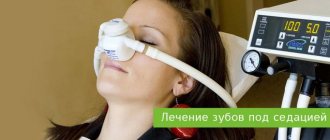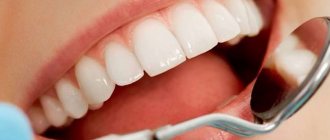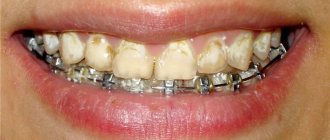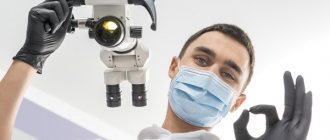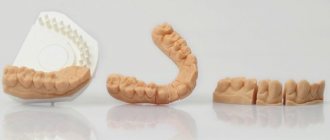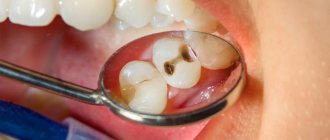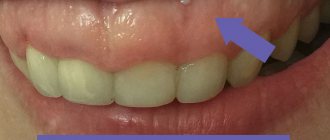Sore throat is not a symptom of caries and is characteristic of other diseases: tonsillitis, laryngitis and pharyngitis. But this does not mean that these pathologies are not related. One of them may cause the development of others. We will find out what connection there is between a sore throat and dental caries and tell you what to do if it occurs.
In this article
- What is caries: causes and mechanism of development
- Stages of caries
- Complications of carious lesions: can your throat hurt due to caries?
- Sore throat due to tonsillitis
- Laryngitis and sore throat
- Pharyngitis and sore throat
- Caries and lymphadenitis
- How to avoid caries complications
- What dental pathologies can cause a sore throat?
- Is it possible to treat teeth if your throat hurts?
- General recommendations for dental care
Typically, people associate a symptom such as a sore throat with a sore throat - an acute infection of the tonsils. Indeed, with this disease a person always has a sore throat, which should already be a reason to visit a doctor. However, there are other possible causes for this symptom.
Can it cause tooth decay? This is not possible directly: a sore throat is not one of the components of the symptoms of a carious lesion. But it can lead to throat problems indirectly, that is, through other pathologies, provoking them or increasing the risk of their occurrence. We will tell you how caries develops, what complications it leads to and why.
What is caries: causes and mechanism of development
Caries is a pathological process that destroys the hard tissues of the tooth - enamel and dentin. It occurs when cariogenic microorganisms actively multiply in the oral cavity, releasing harmful acids. They reduce the pH of the oral fluid, oxidize the enamel and destroy its structure, leaching various microelements from it. It does not have time to recover naturally and cannot protect the internal tissues of the tooth from external influences.
Caries develops under the influence of many factors, including:
- poor hygiene;
- improper growth of teeth;
- excessive consumption of sweets;
- smoking;
- weak immunity, etc.
About 90% of people suffer from this pathology to one degree or another. However, it is not difficult to cure it, at any stage. To do this, you just need to contact your dentist in time and start treatment. If you ignore the symptoms of tooth decay, it can cause complications, some of which are accompanied by a sore throat.
Case 4. The source of inflammation at the root of the tooth - the so-called. cyst
Imagine the situation.
A tooth that previously did not have a filling or was previously treated endodontically begins to hurt. An examination is carried out, X-ray control is done, but often a more informative cone-beam computed tomography CBCT or, as many say, a 3D x-ray is performed. A dental cyst is detected. The doctor recommends removing the tooth because there is a large area of inflammation at the top of the tooth root, caused by an infection in the root canal. The infection gets beyond the root tip and causes inflammation. This inflammation can be treated by removing the infection from the root canal. It is easier for a doctor who does not have the knowledge and treatment methods to remove a tooth.
How to do it right:
There is no need to remove the tooth. In the case of a dental cyst, it is necessary to carry out diagnostics, examination and high-quality treatment under the control of an operating microscope with isolation of the working field, followed by hermetically sealed restoration of the tooth at the stage of endodontic treatment. The recommendation is simple:
before removing a tooth, consult a professional. You may not need tooth extraction! This means that sinus lifting, implantation and prosthetics procedures following the removal will not be necessary.
Stages of caries
Doctors distinguish 4 stages of caries, which determine the method of its treatment. Each of them has its own symptoms. At the first stage (initial), a chalky (white) stain forms on the tooth surface, which indicates the process of demineralization of the enamel. It becomes less calcium, fluorine and other trace elements. At the same time, it does not have time to recover naturally and slowly collapses.
At the second stage (superficial), the pathology penetrates deep into the enamel, but continues to remain within its boundaries, without affecting the dentin. There is no carious cavity at this stage yet, but the patient is already worried about the first symptoms of the disease: his tooth may hurt when eating sweet foods, or less often - hot and cold. The pain subsides after the stimulus is removed.
At the third stage (middle), a carious cavity is formed - a cone-shaped hole of a brownish color. Bacteria quickly multiply in it and penetrate the dentin. Pain occurs when there are temperature changes, from sweet and sour foods, and also when brushing your teeth.
At the fourth stage (deep), the carious cavity is a large hole of almost black color. A person’s breath constantly smells bad, the tooth hurts often, and the pain is sharp and sharp. It can occur at rest. There is a risk of caries spreading to the soft tissues inside the dentin, that is, to the pulp.
Complications of carious lesions: can your throat hurt due to caries?
A carious lesion is a permanent source of infection. Bacteria, mainly streptococcal bacteria, multiply in it, which can spread to other parts of the oral cavity: gums, tongue, mucous membrane or throat.
Under certain conditions, for example, after hypothermia, with reduced immunity or during a cold, these microbes can provoke infectious diseases, including tonsillitis, laryngitis and pharyngitis. These diseases may cause a sore throat. Let's briefly look at their features.
Sore throat due to tonsillitis
Tonsillitis develops when pathogenic bacteria and viruses, including streptococci, which cause caries, enter the tonsils. Often, the causative agent of the disease penetrates the oral cavity and enters the throat along with inhaled air or food. However, an endogenous variant of infection is also possible, when microbes infect tonsil tissue from foci of infection in the oral cavity. The development of the infectious process is also facilitated by:
- tonsil injuries;
- chronic diseases of the mouth and nose;
- violation of nasal breathing;
- various somatic diseases.
Tonsillitis can occur in acute and chronic forms. An exacerbation of this pathology is also called sore throat, which is always accompanied by a sore throat. Inflammation of the tonsils also has other symptoms, which depend on the type and form of the disease.
Typical signs of tonsillitis are:
- sore throat that gets worse when swallowing;
- irradiation of pain into the ear;
- increased body temperature;
- putrid breath odor;
- general weakness, decreased performance;
- headaches, muscle and joint pain;
- dry cough.
In very severe cases, severe swelling of the tonsils is possible, which makes breathing difficult. Tonsillitis is treated therapeutically using antiviral, antibacterial and antifungal agents, as well as antibiotics.
Indications for dental treatment for colds
You can visit the dentist, but at the appointment, after an examination and history taking, the dentist will decide on the advisability of treatment in this situation. However, there are situations when seeing a doctor is mandatory:
- Cold symptoms such as headache, weakness, fever, and so on developed a few days after the onset of signs of dental disease or simultaneously with them. This may indicate that the condition that is mistaken for ARVI is actually a complication of pulpitis, a cyst on the root of a tooth, or another pathology of the oral cavity.
- Severe and constant pain in the tooth that does not calm down after taking painkillers, swelling of the gums around the painful tooth or on the corresponding side of the face. In such situations, treatment for the disease that is causing these symptoms may be necessary to prevent the infection from spreading throughout the body.
- Purulent discharge is observed from the gums near the diseased tooth, and the body temperature is greatly increased and does not decrease after taking antipyretics.
All of the listed conditions do not yet guarantee that treatment will be provided when visiting a dentist. The doctor may reschedule the appointment until complete recovery or begin the necessary manipulations if the benefits of treatment outweigh the possible risks.
Laryngitis and sore throat
Laryngitis is an inflammation of the larynx that is infectious in nature. The inflammatory process can develop as an independent disease or as a complication of systemic infections, for example, measles, ARVI, influenza, etc. Depending on the form and type of laryngitis, it can be accompanied by various symptoms.
Common features are:
- Swelling of the throat. Patients complain of a feeling of squeezing in the neck, as if a tight bandage had been placed on it.
- Hoarseness of voice. It gets worse when a person raises their voice or speaks for a long time.
- Discomfort when swallowing, especially cold and hot foods.
- A sore throat, a constant desire to cough, causing the throat to become even more irritated.
- Accumulation of mucous secretions in the throat; it seems to a person that they are flowing directly from the nasal cavity.
Pain in the throat occurs only when swallowing; The pain cannot be called strong and intense, but it causes a lot of inconvenience. In addition, headaches occur, body temperature rises to approximately 38°, and weakness and malaise bothers you.
Is it possible to treat teeth if you have a cold?
90% of specialists will answer this with a firm “no,” citing the following arguments:
- A healthy body has more strength for regeneration, which will be needed to heal inflamed gums, mucous membranes, sprout new nerve endings and stop bleeding.
- The effect of local anesthetics is reduced, because During inflammatory processes in tissues, the pH of the environment changes to the acidic side. A large dose of the same procaine is required to achieve complete pain relief. Increased doses of medications can cause allergic reactions. Considering that the manipulations are carried out near the throat, this is fraught with Quincke's edema.
- With a wet cough, sputum is actively expelled. At the most inopportune moment, you can cough in the doctor’s face, and healing also worsens. Sputum is characterized by the content of not only dead microorganisms, but also living, pathogenic ones. If it gets on inflamed gums, it can cause infection and complications including osteitis (bone inflammation) and sepsis.
Pharyngitis and sore throat
Pharyngitis is an inflammation of the pharyngeal mucosa that is caused by bacteria, viruses and fungi. More often, a person becomes infected with this disease through inhaled air and food, but other routes of infection are also possible, for example, from a carious tooth. With this disease, the throat hurts and the temperature rises to 37.5-38 °C.
Depending on the type and form of the pathology, the following symptoms may occur:
- redness of the throat;
- rashes on the oral mucosa;
- purulent plaque on the throat;
- runny nose, dry cough, tickling;
- weakness and fatigue;
- muscle pain.
Pharyngitis can be caused not only by caries, but also by other dental diseases, including stomatitis. Inflammation of the pharyngeal mucosa can be treated quickly enough, but complete lack of treatment leads to the development of chronic pharyngitis.
Caries and lymphadenitis
Tooth decay can negatively affect the lymphatic system. Lymph nodes act as filters in the body, trapping harmful microbes and destroying them. Lymph nodes are also involved in strengthening the immune system.
Due to the spread of cariogenic bacteria, for example, with advanced caries, inflammation of the lymph nodes can occur. They increase in size and hurt. One possible symptom of lymphadenitis is pain when swallowing. Inflammation can be eliminated with the help of medications, but it will occur again if the underlying disease is not treated, in this case, caries.
What is the danger of coronavirus infection?
Coronaviruses are a group of viruses that are transmitted to both humans and animals. Coronaviruses have been known to medicine for a long time, but in 2022, a new and particularly dangerous strain of coronavirus appeared, called COVID-19. Once in the human body, this strain of coronavirus can cause inflammatory processes in the respiratory tract and lungs, affect the gastrointestinal tract, and cause the development of bronchitis and pneumonia. Coronavirus poses a particular danger to people with various chronic diseases, weakened immune systems, and the elderly.
It is important to understand that even if you do not belong to a risk group, you can still get sick with coronavirus and infect people with whom you come into contact. And among your contacts there are probably people for whom coronavirus poses a serious threat!
The COVID-19 coronavirus strain is highly contagious and is transmitted primarily through airborne droplets. And measures such as wearing medical masks, constantly washing your hands and treating them with an antiseptic do not provide 100% protection against coronavirus infection.
Scientists and doctors around the world are working to create a vaccine and medicines that would help effectively fight coronavirus infection, but, alas, they have not yet been able to create such drugs. Therefore, the only measure that can contain the spread of coronavirus in Russia and in the world remains the self-isolation regime, which makes it possible to reduce contacts between people to a minimum.
To stop the spread of coronavirus, it is important for all of us to stay at home and not leave the premises unless absolutely necessary.
Take a short test and calculate the cost of treatment!
Take a short test
- Which teeth have caries?
- Visual assessment
- Reaction to stimuli
- Cost calculation
×
Manukyan Artavazd Genrikovich
Chief physician of the clinic
How to avoid caries complications
The main danger is advanced caries, which at any time can provoke pulpitis, periodontitis, lymphadenitis and other pathologies. If a person has a weak immune system, the likelihood of these complications increases many times over. The best way to avoid them is to treat tooth decay on time. Dentists recommend coming for an examination every six months, during which even hidden forms of carious lesions can be identified at the initial stage and treated.
At the first and second stages, when a carious cavity has not yet formed, remineralization is carried out - saturation of the enamel with minerals. A composition enriched with calcium and fluoride is applied to the tooth surface, which allows you to quickly restore the enamel structure and normalize the balance of microelements in the oral fluid. Remineralization is prescribed in a course lasting from 5 to 15 sessions, depending on the condition of the teeth. To enhance the remineralization therapy, the patient should use toothpastes, gels and rinses with minerals: Mirafluor C Toothpaste with Amine Fluoride, DRC ROCS (ROCS) Medical Minerals and Vivax "Remineralization". During treatment you need to give up smoking and sweets.
If there is a carious cavity, the dentist prepares the diseased tooth, that is, cleanses the cavity of dead tissue, and installs a filling. In some cases, when soft tissue is involved in the pathological process, the pulp is removed. If the tooth is severely damaged, dentures may be required. If none of these methods is suitable, the diseased tooth is extracted. An implant can be installed instead.
Of course, a sore throat can occur not only because of the listed diseases and caries, as one of the reasons for their occurrence. There are other pathologies that are accompanied by this symptom. We'll tell you what dental diseases it appears in.
What services are provided by Aesthetica dentistry during the coronavirus quarantine?
Our dentistry “Aesthetica” is working in a special mode during the coronavirus quarantine period. We accept patients only for acute pain and emergency conditions requiring urgent dental treatment. These conditions include:
- Severe toothache;
- Swelling of the gums, swelling of the cheek or face;
- Continuous bleeding after tooth extraction;
- Serious injuries to teeth, gums, tongue, jaw;
- Flux;
- Pulpitis, periodontitis, periostitis;
- Emergency care is required for patients undergoing orthodontic treatment when the arch of braces is damaged, the locks of the system come off, damage to soft tissues and teeth;
- Reimplantitis;
- The occurrence of complications after prosthetics, manifesting themselves as acute pain and swelling of the gums.
To get an appointment with our dentists before the end of the self-isolation regime introduced to prevent the spread of coronavirus, you need to make an appointment by calling the clinic phone number, which is listed on our website. To visit a dentist, we advise you to choose the Aesthetica branch that is located as close as possible to your place of residence - in Barvikha or in Podsosensky Lane.
What dental pathologies can cause a sore throat?
The throat hurts due to stomatitis, improper eruption of wisdom teeth and periodontitis. The most insidious of these diseases is stomatitis - inflammation of the oral mucosa that develops as a result of injuries, infections and allergies. Because of it, many small ulcers form in the mouth, each of which is a source of bacteria. Stomatitis often goes away on its own, so rarely does anyone go to the hospital with it. However, this is the danger of the pathology - it can cause other diseases, including sore throat.
The main signs of stomatitis are ulcers on the oral mucosa and pain while eating. There may also be a discharge of translucent exudate, the formation of white plaque and swelling of the gums. In severe cases, when a person has a weak immune system, the temperature rises, chills and fever bother them.
A sore throat may be caused by the eruption of wisdom teeth. First, pain appears in the gums. If it grows in the wrong direction, it can injure the mucous membrane and lead to the development of inflammation. The pain is localized in the throat and lower neck, and the lymph nodes are often inflamed.
If your throat hurts, but there are no signs of laryngitis, pharyngitis, tonsillitis, an examination is carried out for the presence of periodontitis - an inflammatory disease of the tissues surrounding the tooth. As a rule, it occurs due to non-compliance with hygiene rules. Caries can also cause periodontitis.
Inflammation is accompanied by pain when severe. The throat is not involved in the pathological process, but the patient may complain of pain when chewing and swallowing. Treatment of periodontitis is carried out by cleaning gum pockets and antibacterial therapy.
Case 3. An instrument broke in the canal
We often come across cases when patients come to us who, during treatment in other clinics, have had a broken instrument in the root canal.
But the patient has no idea about this, since the attending physician himself did not notice it. When treating inflammation, in the absence of a microscope at hand, this remaining instrument interferes with the full treatment of the root canal. And the doctor, without seeing this instrument, cannot remove it, making full root canal treatment possible. Therefore, the patient is recommended to have the tooth removed. But is it necessary to remove the tooth in this case? - No.
How to do it right:
Contact a clinic that has a dental microscope in its arsenal.
Under high magnification, the doctor will be able to see the problematic root canal and see the remaining fragment of the instrument. Then carefully remove it, treat the root canal and eliminate inflammation. This allows the patient to save the tooth without having to remove it. Effective treatment of the above situations has become possible thanks to the use of dental microscopes in dental practice. Don’t skimp on your dental health; go to clinics that are equipped with microscopic treatment technologies.
General recommendations for dental care
If you follow a number of rules, your teeth and throat will hurt less often:
- brush your teeth twice a day;
- change your toothbrush every three months;
- use irrigators to clean the oral cavity;
- rinse your mouth after every meal;
- use dental floss for additional hygiene;
- Visit your doctor every six months for ultrasonic cleaning.
Do not ignore symptoms such as sore throat, inflammation of the lymph nodes, ulcers on the oral mucosa, etc. If they appear, consult a doctor immediately.
Is it safe to visit the dentist during a pandemic?
Let us answer right away - yes, it is completely safe! At the MediLine clinic, we pay special attention to sterility: we use a personal set of instruments for each patient. This set includes both disposable consumables and reusable instruments that undergo a full processing cycle. We have a separate sterilization unit with disinfection devices, including a modern German autoclave DAC UNIVERSAL. After sterilization, instruments are stored in special ultraviolet cabinets, which guarantees the safety of their use.
The doctor conducts the consultation only wearing a disposable mask and gloves. Several times a day we carry out quartz treatment in each office to disinfect the air in the room. Appointments are carefully scheduled to minimize the number of patients in the waiting area. We work according to the highest international standards, so treating teeth during a pandemic at MediLine is as safe and comfortable as always.

